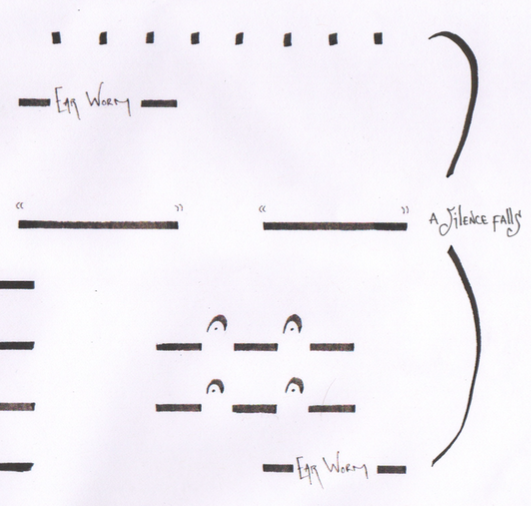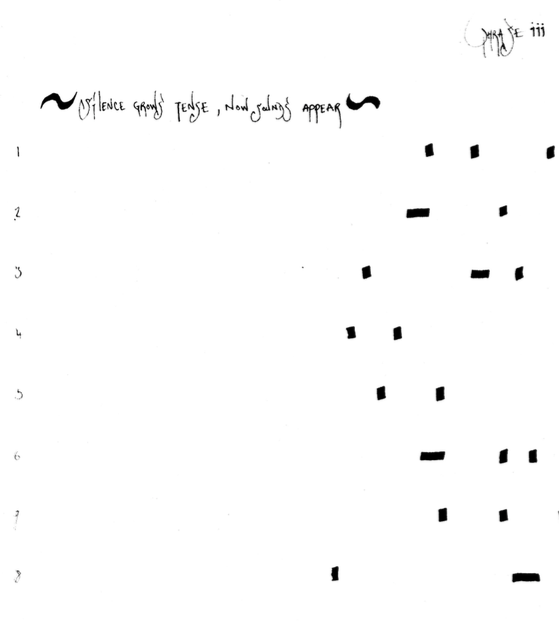Following from my previous post, here is the outcome of an email exchange with Tisha Mukarji about the piece she wrote for the a.pe.ri.od.ic ensemble’s commission. Tisha is based in Berlin, and she is active as a composer, an improviser, and a writer. Her primary instrument is inside piano. Her scores tend to have a highly developed and characteristic visual component, and Fugitive Counterpoint is no exception, as you will see in the images from the score that I’ll include below.
Transitions and relationships seem very important here: “a silence falls” – gradual/abrupt/impossible silences; tonal relationships are to flicker/quiver/disturb. Does that relate in some way to your experience with improvisation? For example, conversations or relationships between players in the moment.
Re: Tonal Relationships: Simply put my interest in tonal relationships: one note in relation to another, is what I like listening to, notes being tuned. Every note when played in relation to any other note produces a relationship (besides the obvious harmonic one) – and here for this piece I’ve mentioned 3 possible categories for these relationships. Where the notes flicker, quiver, and/or disturb one another.
For me it’s such a beautiful way to suggest music, since each word will be an indication and an instruction.
One could of course provide the exact ratios of what I’m after but where is the fun in that ? I’d rather listen to suggested angles than ratios. (oh I might get into trouble here….)
I don’t think you’re about to get into trouble over your tuning comment. These are two different methods of transport within a very wide territory.
I like how you put this, as methods or modes of transport, I wonder if you also envision a destination with that? What would it be? Where would it take us?
Relationships are indeed important, this is a big question.
In a way yes there is a link to improvisation, but only in the sense of how I approach it, when I improvise I often try and disturb the tones in one way or another, so a note can be played and I will follow it and perhaps play it tuned slightly to produce beatings, or I find that my role is one where I punctuate the main flow the music is taking. So this I think has more to do with music rather than to the performers per se.
Of course there are many possibilities to approach improvisation and they often shift during the music. There are certainly many improvisers who don’t approach it at all in the sense that they don’t plan anything in advance…so I’m a bit of a cheater…I see improv as a space where the main question is when to play.
I’d be interested to know the significance of the dedication to Jean McGarry.
Jean McGarry (a wonderful, marvellous writer) whose interruption in my life has provided the foundation of the piece and in fact every part of the piece has some connection and resonance to her. Under her many influences I started reading Proust’s In Search of Lost Time – which inspired the title, and the idea of combining the ear worm as an interruption and an obsessional listening.
(I could go on and on here….but I stop for now)
Now I want to read some Jean McGarry. Is there a story you’d suggest reading first? Maybe something to do with this ear worm?
Ah yes…difficult question…where to begin? There isn’t a story that I’ve come across (yet) that mentions the ear worm. It was in a particular setting that I could observe her absorbed listening. During a residency in Italy, a beautiful castle, incidentally, Civitella Ranieri.
What I find incredible about her writing is its density. The prose is incredibly compact and presents different angles simultaneously. Reflective angles that dance back and forth, overlap and collide.
(Do you know Hanna Hartmann’s music ? It has some resemblance to McGarry’s structure – the multi layered, compact compositions yet with very clear voices – are we going off on a tangent? Is there space here?)
I was struck while reading Dream Date, a collection of short stories….start there. In particular a story entitled Better Than Real, which combines simultaneous voices/lines of thought with realities…
What is the importance of the ear worm to you? Is it a kind of infiltration from the outside world?
The ear worm is something I’m beginning to think about, it has a disruptive quality that is potentially interesting in a flow. I don’t often get ear worms but Jean McGarry is someone who in her words “is bedevilled by ear worms”. So I thought I would play with that a little. I suppose it’s funny to dedicate a piece to someone that deals with what is, in the end, annoying. It’s a gift bound to irritate! So for her, it’s definitely an unwelcome infiltration, indeed.
For me I see it as an interesting interruption, that is surprising, also I think it’s a peculiar instruction to give a performer, to instruct him to be involuntarily affected, the pinnacle of control!
There is an additional point that she made: that she has to be careful since she absorbs lines of music, so for me to be absorbed so intensely is a specific type of listening – what and how is it that a listener becomes so absorbed?
Each phrase is a page, and is offset by a silence. The silences seem to take on a structural role in the page layout. The project calls for “structured indeterminacy,” and it seems to me that the pages, the silences (sometimes brackets), lines, punctuation, and ear worms are part of a larger structural intent. Is there an architectural analogy that seems fitting for these structural elements?
I’m curious about your architectural analogy, can you say more?
I think I latched onto the architectural analogy because of the page layout. Each section has a separate page (except for phrase iv which is only described in text and not represented visually). So I start imagining each section as a separate room, with a silence as a doorway or sometimes a hallway to the next room.
Jennie I love this image, yes I see the silences as a large hallway connecting large resonant rooms in the wing of an empty castle….
I must now confess that when I wrote down the third phrase (which is only a suggestion as to overlaps and duration of the sounds) I was shocked how similar it looks to Earle Brown’s December 1952 piece…
I haven’t said anything about the silences yet….I leave you with this for now. (Still nothing on silences yet)
I see some of the silences in this piece as being the thing that the players are really doing together. On a more local level, the fermatas probably have to be somehow cued, and then they all go into those larger silences together.
Yes you’re exactly right, the silences are to be performed and synchronised together. On the other hand the fermatas although visually in sync are not an indication of synchronous pauses between the musicians, I would hope that there is some unruliness, so that the individual lines appear and disappear independently. Within a more synchronised disappearing and reappearing at the beginning and end of each section.
-I’m using these silences as an instruction to listen and different silences produce different types of listening. They are highly dependent on the music being played – if the music is already too quiet and sparse then an “abrupt silence” will not be abrupt enough…for me as a performer I find this provokes a lot of questions.
The silence in the third phrase is in fact a quote from a passage in Rilke’s The Notebooks of Malte Laurids Brigge: the character is at an evening where music is being played and suddenly he is struck by a singer and the silence the singer commands and imposes amongst the guests.
I suppose, now that I’m thinking about it, I’ve placed three types of silences/listening and lines of music in relation to one another.
McGarry’s Ear Worm, Rilke’s absorption and Swann’s obsession.
I see this piece as the first in a much larger series exploring the variations and different relationship of each part: phrase, ear worm silence etc.
I’m interested to know a little more about the series you’re envisioning. For one thing, would it be for specific ensembles, or open instrumentation? Would this kind of formal construction carry over into the new pieces? Whatever you’d like to say about the rest of the series as you imagine it would be great.
I see the series as an ongoing study of fugitive phrases, to explore the variations, the obsessions. I definitely see the tonal and temporal relationships being fixed even further. As to instrumentation this is not fixed as yet, despite the fact that I have some clear ideas I would like to try out with ensembles there are the great logistical constraints to think about.



